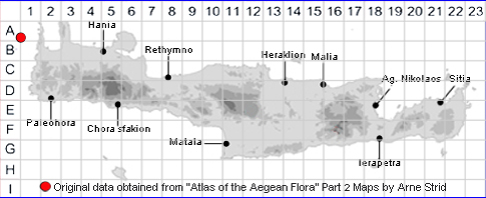
SPECIES DESCRIPTION
ALLIUM PLATAKISII
Family and Genus:- See- ALLIACEAE/Sect. CODONOPRASUM
Common Names:- None
Homotypic Synonyms:- None
Meaning:- Allium (L) The ancient Latin name for garlic.
Platakisii (L) Named after the Greek naturalist E. Platakis.
Resembling A. tardans, described below but with the following differences:
1) Leaves sheathing the stem only halfway
2) Inflorescence with more numerous, short-pedicellate flowers.
3) Flowers narrowly urceolate with whitish perianth segments 6-7 mm.
General description:- Bulbous perennial plants, usually smelling strongly of garlic
or onion.
Bulb:- 10-15 mm diam; outer tunics membranous, breaking into strips, continued
upwards as a neck around base of the stem.
Stem:- 10-30 cm.
Leaves:- 3-4, up to 160 x 0·5 mm, Thread-like, withered at flowering time, much
longer than the stem, sheathing the lower 7/8 of the stem.
Flowers:-
1) Spathe 2-valved; valves persistent, unequal, one 25-40 mm, much longer than the
umbel, narrowly triangular at the base, contracted above into a long appendage, the
other valve 7-20 mm.
2) Umbel 10-25 mm diam, parallel, clustered, and erect, 6-15-flowered.
3) Perianth bell-shaped, erect; segments 5-6·5 x 1·8-2 mm, pale pink, with green
mid-vein, the outer narrowly oblong, the inner Inverted lance-shaped, rounded and
almost truncate at apex.
4) Stamens included or with anthers partly exserted; filaments 5-5·5 mm, united at
base into an annulus 1·5 mm high; anthers pink before dehiscence, later whitish.
5) Ovary narrowly oblong-ellipsoid, deeply grooved lengthwise.
Fruit:- Capsule 4.5 mm.
Key features of Allium platakisii
1) Perianth cylindrical, somewhat urceolate.
2) Leaves sheathing the stem c. halfway.
3) Perianth segments 6-7 mm, whitish.
For a more detailed account of Allium platakisii
See https://www.herbmedit.org/flora/3-309.pdf
Habitat:- Coastal limestone cliffs'
Distribution:- Endemic to Crete. Described in 1993 and so far known only from the
small island of Pondikonisi off NW Crete;
Flowering time:- Sept-Oct.
Photos by:-
